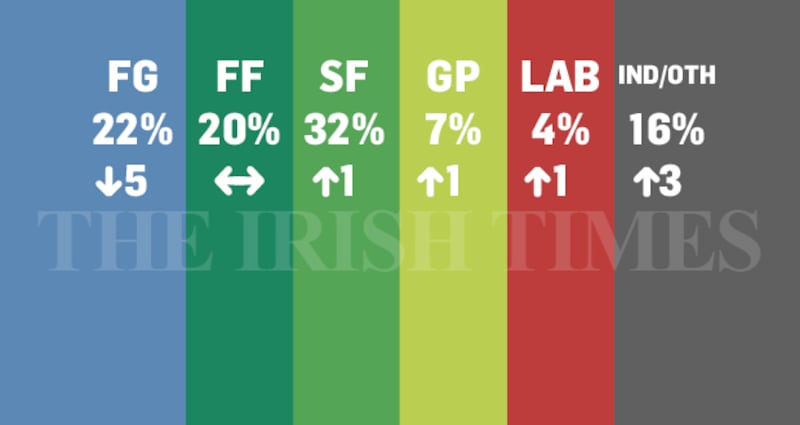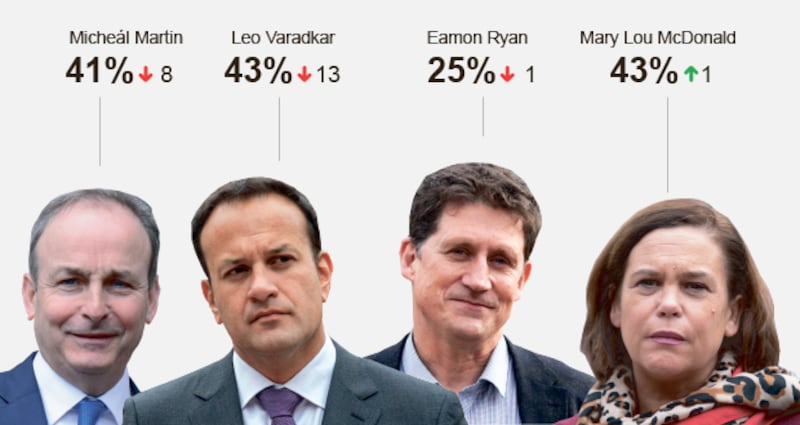The rise and rise of Sinn Féin continues. Mary Lou McDonald's party now enjoys a commanding lead over its main rivals in Fine Gael and Fianna Fáil and is by some distance the most popular party in the State.
Nobody ever won a general election three years before polling day, but Wednesday’s numbers will strengthen Sinn Féin’s position as favourite to lead the next government, while at the same time demoralising their rivals.
Sinn Féin support rises by a point today to 32 per cent, up a point from our last poll in June. It puts the party 10 points ahead of Fine Gael, 12 in front of Fianna Fail. If its rise is slow, it is steady and relentless. Average support for the party in the five Irish Times/Ipsos MRBI polls since the general election is 29 per cent.
The fact remains that support for Fine Gael has fallen in every single Irish Times/Ipsos MRBI poll for 12 months now
Given a modest seat bonus such as large parties tend to enjoy, that level of support should return 50-plus seats at the next general election. Anything remotely like this set of numbers at the next election would put Sinn Féin so far in front of its rivals in the next Dáil that it is difficult to imagine a government led by anyone else being formed after it.
The strong position measured by Wednesday’s poll comes after a period in which politics has begun to normalise after the long period during the worst of the pandemic when politics-as-usual was effectively suspended.
There was one issue dominating politics, and that issue was dominated by the Government. Insofar as the opposition had a role to play, it was one which in any case half-supported the Government in most of the big decisions.
But with the gradual return of a more conventional political discourse, issues like housing and healthcare have begun to reassert their salience. These are issues on which Sinn Féin has been highly effective in hammering the coalition. And that seems likely to continue.
For the coalition parties, there are admittedly mixed messages in Wednesday’s numbers. For the Green party, the news is not that bad, actually.

The party gains marginally to register at 7 per cent, the same level of support it recorded at the general election in 2020. The baleful predictions from everywhere that the Greens would be destroyed if they entered Government have not been borne out. Why not?
There is, of course, plenty of time left for things to go disastrously wrong for the Greens. And the party will face headwinds inside and outside government in the coming months as it seeks to define and apply the measures that will be necessary to achieve the climate action goals now laid down in legislation.
But so far, being in government is working for the Greens because they are getting the things they set out to get, and those things are important to the people who might be inclined to vote for the party.
They will not appeal to many voters – maybe a majority of voters. But they do appeal to those voters who want climate action at the top of the Government’s list of priorities.
The avowed political strategy of the party leader – to make tangible improvements in these areas and thus reap a political dividend – remains a precarious one
The news for the two big Government parties is less encouraging. It is quite wretched for Fine Gael. The party sees its support fall by five points since June, a slump which leaves it at 22 per cent, its lowest rating since the general election. Tánaiste and party leader Leo Varadkar sees his personal rating fall by a whopping 13 points, to 43 per cent.
It will be little consolation to Varadkar that this marks a return to more “normal” levels, after a period in which his personal rating was driven to stratospheric levels during the pandemic, particularly during its early phase in the first half of 2020. Government satisfaction plummets by seven points to 46 per cent.
The Fine Gael dive in Wednesday’s poll may be just another aspect of the return to post-pandemic politics. But the fact remains that support for the party has fallen in every single Irish Times/Ipsos MRBI poll for 12 months now.
It’s true that these latest discouraging numbers come after a period of largely self-inflicted political harm through the controversy over Katherine Zappone’s botched appointment. But it would be a brave man who would say that is the last mistake Fine Gael will make; or who would say that the bottom of this downward trend has been reached.

Warning signs
Taoiseach Micheál Martin also sees his approval rating nosedive, by seven points to 41 per cent. His party fares rather better, holding steady on 20 per cent today after a period in which it bounced around the teens, falling as low as 14 per cent in the early part of this year. So the party will be content that it is holding its own at a time when Government popularity is declining.
But the warning signs are there for Fianna Fáil as much as for its partners. If the return to normal politics heralds a return to focus on health and housing, remember these are precisely the areas for which Fianna Fáil ministers are responsible.
The avowed political strategy of the party leader – to make tangible improvements in these areas and thus reap a political dividend – remains a precarious one.
For the smaller parties and independents, the aggregate level of support goes up by three points, from 13 per cent to 16 per cent. There are marginal increases for the Social Democrats (from 2 per cent to 3 per cent), and for the independents (up two points to 10 per cent) while Aontú (1 per cent) and Solidarity/People Before Profit (2 per cent) show no change since June. Meanwhile, the Labour Party goes up by a point to 4 per cent.
The overall picture of the opposition is one of domination by Sinn Féin, which voters see as by far the leading option for change. The Government, meanwhile, is now an administration that is under increasing pressure – even as the political challenges it faces grow ever larger, and more daunting.










